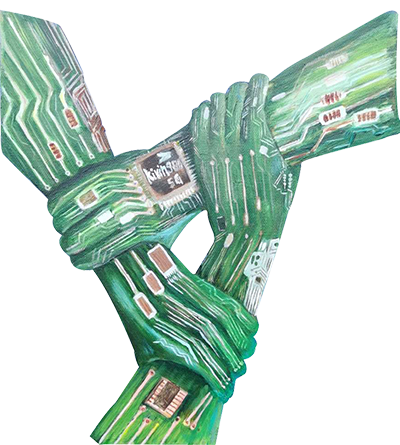What is the PCB circuit board processing flow?
Date:2020.09.29Views:481
【Inner layer circuit】The copper foil substrate is first cut into a size suitable for processing and production. Before pressing the film on the substrate, the copper foil on the surface of the substrate should be roughened by brush grinding and micro etching, and then the dry film photoresist should be tightly attached to it at appropriate temperature and pressure. The substrate with dry film photoresist is sent to the UV exposure machine for exposure. The photoresist will polymerize in the transparent area of the negative film after being exposed to ultraviolet radiation, and the line image on the negative film will be transferred to the dry film photoresist on the plate surface. After tearing off the protective adhesive film on the film surface, the UN illuminated area on the film surface is removed with sodium carbonate solution, and then the exposed copper foil is corroded and removed with hydrogen peroxide mixed solution to form a circuit. Finally, light oxide aqueous solution was used to remove the dry film.
[Lamination] The inner circuit board shall be bonded to the outer circuit copper foil with glass fiber resin film. Before pressing, the inner layer plate should be blackened (oxidized) to passivate the copper surface and increase the insulation; and the copper surface of the inner circuit should be coarsened so as to produce a good adhesion with the film. The inner circuit boards with more than six layers (including) shall be riveted in pairs by riveting machine. After that, the plates are stacked between the mirror plates and sent into the vacuum press to harden and bond the films with proper temperature and pressure. The pressed circuit board uses the target hole drilled by the X-ray automatic positioning drilling machine as the reference hole for internal and external circuit alignment. And the plate edge should be cut properly to facilitate subsequent processing.
[drilling] drill the circuit board with a CNC drilling machine to drill the through hole of the interlayer circuit and the fixed hole of the welding parts. When drilling holes, pins are used to fix the circuit board on the drilling machine tool table through the previously drilled target holes. At the same time, flat lower backing plate (phenolic resin board or wood pulp board) and upper cover plate (aluminum plate) are added to reduce the occurrence of drilling burr.
[plated through hole] after the formation of the interlayer through hole, a copper layer should be laid on it to complete the conduction of the interlayer circuit. Firstly, the burr on the hole and the powder in the hole are cleaned by heavy brush grinding and high-pressure washing, and then the cleaned hole wall is soaked and attached with tin
[primary copper] palladium colloidal layer, and then it is reduced to metal palladium. The circuit board is immersed in the chemical copper solution, and the copper ions in the solution are reduced and deposited on the hole wall by the catalysis of palladium metal to form a through-hole circuit. Then the copper layer in the through hole is thickened by copper sulfate bath electroplating to a thickness sufficient to resist subsequent processing and environmental impact.
[secondary copper for outer circuit] it is similar to inner circuit in image transfer, but it is divided into positive and negative production methods in circuit etching. The production method of negative film is like the production of inner layer circuit, which is completed by directly etching copper and removing film after development. The production method of positive film is to add secondary copper and tin lead plating after development (the tin and lead in this area will be retained as etching inhibitor in the later copper etching step), and the exposed copper foil will be corroded and removed by alkaline ammonia water and copper chloride mixed solution after film removal to form a wire circuit. Finally, the tin and lead stripping solution is used to remove the tin and lead layer which has been successfully retired (in the early stage, the tin lead layer was retained and used to cover the circuit after heavy melting, which is now mostly not used). [solder proof ink text printing] the earlier green paint was produced by direct hot drying (or ultraviolet radiation) after screen printing to harden the film. However, in the process of printing and hardening, the green paint often penetrates into the copper surface of the line terminal contact, resulting in the trouble of parts welding and use. Now, in addition to the simple and rough circuit board, the photosensitive green paint is often used for production. The words, trademarks or part marks required by customers shall be printed on the board by screen printing, and then the words shall be hardened by hot drying (or ultraviolet radiation).
[contact processing] solder proof green paint covers most of the copper surface of the circuit, and only the terminal contacts for welding parts, electrical test and circuit board insertion are exposed. In order to avoid oxide formation at the end of the connected anode (+) in long-term use, it is necessary to add an appropriate protective layer at the end point, which will affect the stability of the circuit and cause safety concerns. [forming and cutting] the circuit board is cut into the external dimensions required by customers by CNC molding machine (or die punch). When cutting, pin is used to fix the circuit board on the bed (or mold) through the positioning hole drilled previously. After cutting, the golden finger is grinded to facilitate the insertion and use of the circuit board. The X-shaped break line should be added to the circuit board formed by multi-chip, so as to facilitate customers to separate and disassemble after the plug-in. Finally, the dust on the circuit board and the ionic pollutants on the surface are cleaned.
[Inspection board packaging] common packaging PE film packaging, heat shrinkable film packaging, vacuum packaging, etc
